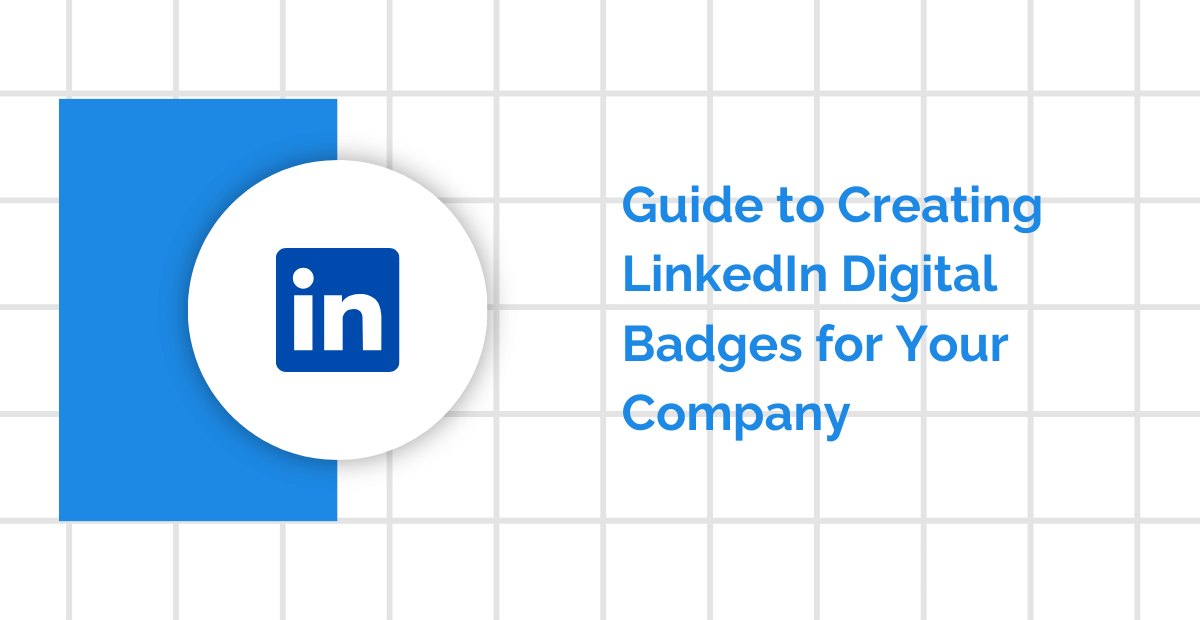Ever wonder how some brands just stick in your mind, while others fade before you even finish scrolling?
That’s the magic of brand awareness—and in 2025, it’s no longer just about ads or logos. It’s about visibility in the digital spaces where real conversations happen. Think of digital credentials like smart, shareable proof of achievement that quietly carry your institution’s name across LinkedIn profiles, email signatures, and beyond.
In this blog, we’ll break down how digital credentials are helping schools, training providers, and even government agencies stand out online, without shouting.
So, what is brand awareness?
Think of it as being recognized in a crowded room. If people know your name, what you do, and why you matter—they’re more likely to trust you, buy from you, or choose to study with you.
Brand awareness isn’t about showing off. It’s about staying top of mind when a student is hunting for a course… or when an employer is scanning resumes for credible certifications.
At its core, brand awareness means:
-
People know your name.
-
They remember what you offer.
-
And most importantly—they talk about it.
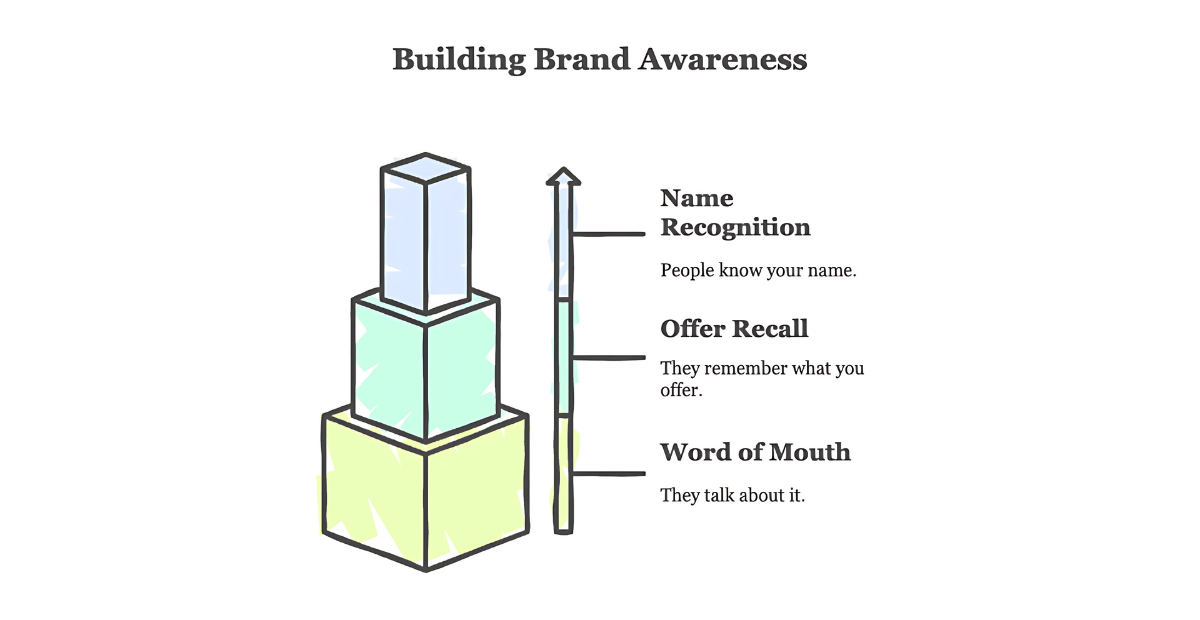
Why traditional methods aren’t enough anymore
Billboards, brochures, email blasts—they still have a place. But let’s be real: Gen Z and Millennials? They live online.
If your institution isn’t actively building presence through authentic, social, and shareable content, you risk becoming invisible.
The world is moving fast. Algorithms change. Attention spans shrink.
Institutions that rely only on traditional brand promotion strategies are finding it harder to keep up.
That’s where digital credentials step in.
What are digital credentials (and why should you care)?
Let’s say a student completes a course on data analytics. Instead of just handing them a PDF or printed certificate, you issue a digital badge or digital certificate—a secure, clickable credential backed by metadata that proves it’s legit.
It can be:
-
Shared on LinkedIn, Instagram, or digital portfolios.
-
Embedded in resumes or email signatures.
-
Verified in real-time by anyone who clicks the link.
No fakes. No delays. Just proof that’s portable, polished, and powerful.
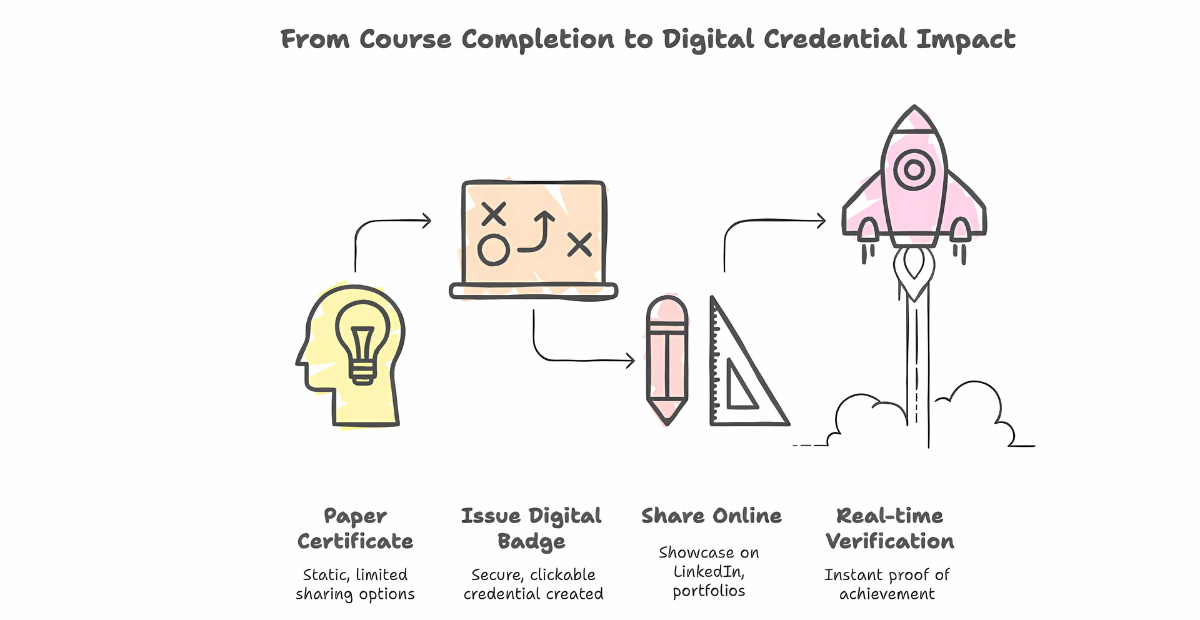
But that’s just the surface. What makes digital credentials truly exciting in 2025 is their built-in adaptability. These aren’t just static awards—they’re dynamic tools that evolve with the learner and carry the brand wherever they go. Each badge or certificate is equipped with metadata—details like issuing institution, criteria met, and skill domains—which builds trust at a glance.
Curious about common doubts learners and institutions face? Explore debunked myths about digital badges.
And for institutions? They act like tiny digital ambassadors. Every time a badge is shared, your logo goes with it. Every click back to your site is a potential enrollment, inquiry, or conversation.
In short, digital credentials don’t just prove something valuable happened—they show who made it happen: you.
Okay, but how do digital credentials actually boost brand awareness?
Let’s walk through it, one platform at a time.
-
Social Media: The snowball effect
You’ve seen it before. Someone posts a badge on LinkedIn: “Proud to have completed XYZ with ABC University!”
That one post? It might:
-
Hit hundreds of views.
-
Get liked and reshared by peers.
-
Show your institution’s name in feeds you’d never reach otherwise.
This is earned media, the holy grail of brand awareness. It’s not you saying how great your brand is—it’s your students, alumni, and partners doing it for you.This is a similar concept to building high-quality backlinks, where a link from a reputable source is a vote of confidence. One of the best ways to achieve this is through guest posting on relevant sites.
Example: Jasmine completes a 6-week leadership course and earns a digital badge. She adds it to her LinkedIn. Her friends, classmates, and even recruiters see it. Suddenly, 600 new people are exposed to your university’s name—without you spending a dime.
That’s the power of shareable proof.
-
-
Your Website: A quiet traffic machine
Most university websites are underused brand assets. But when credentials link back to your verification page or a branded landing page?
Boom—organic traffic.
Every time someone clicks a badge or certificate link, they’re led back to your platform. Maybe they start reading about other programs. Maybe they explore upcoming courses. Maybe they bookmark your site for later.
That’s passive awareness with a purpose.
To learn how organizations strategically integrate credentials into their outreach plans, read our guide on imposing digital credentials into your marketing strategy.
-
Email: Still alive and still effective
Yep, email is still a big deal. Especially when it’s personal and useful.
Here’s the trick: Don’t just send digital credentials—celebrate them.
-
Congratulate earners with a branded email.
-
Include “Share on LinkedIn” or “Add to resume” buttons.
-
Add links back to your courses or learning pathways.
Now you’ve turned a simple email into:
-
A recognition moment
-
A marketing opportunity
-
A traffic driver
And guess what? People do click and share when the email feels like an achievement.
-
-
Content: Let your credentials tell a story
Ever heard the phrase, “Content is king?”
It still rings true—but only if your content is good.
And digital credentials? They’re full of content gold.
Here’s what you can create from just one badge:
-
A blog post: “Meet our Top 5 Earners of the Month”
-
A case study: “How Veronica got hired with our marketing certificate”
-
An Instagram Reel: A quick win from badge to job offer
-
A tweet thread: Breakdown of what the badge covers
You’re not just issuing a badge. You’re telling a story. And stories get shared.
-
-
Referral Power: Let students be your ambassadors
Referral programs are nothing new. But here’s the twist:
Let digital badge holders become your marketers.
Offer simple perks:
-
Share your badge + tag us = 10% off your next course
-
Refer a friend = you both earn a bonus micro-credential
Now your most motivated learners are driving awareness for you, authentically and at scale.
And the best part? It feels like a reward, not an ad.
-
-
Freebies: Give value, gain visibility
Who doesn’t love a freebie?
Try this:
-
Offer a free micro-course on a trending topic.
-
Upon completion, award a verifiable badge.
People sign up. They share their badge. Your name spreads.
Now you’ve gained:
-
New leads
-
Brand exposure
-
A growing learner community
All because you gave something away with real value.
-
-
AI Marketing: Your Secret Weapon
AI is making waves in digital marketing, also known as AI marketing, and it’s a natural complement to a strong digital credential strategy. The insights and analytics from AI tools can help you maximize the impact of your credentials.
Here’s why it works :-
-
Data-Driven Improvements: AI tools analyze user behavior to show how and where digital credentials are shared, helping refine your strategy.
-
Personalized Recommendations: AI-powered platforms like Jasper can draft tailored follow-ups for learners, encouraging them to take the next course or share their credentials.
Pro Tip : Use AI tools to predict trends in sharing patterns for your credentials. This helps you stay ahead of social media or content trends within your industry.
Example in Action : Learn Forward, a corporate training organization, uses AI to track which of its badges are popular on various platforms. This enables smarter, more targeted marketing campaigns that attract more users.
-
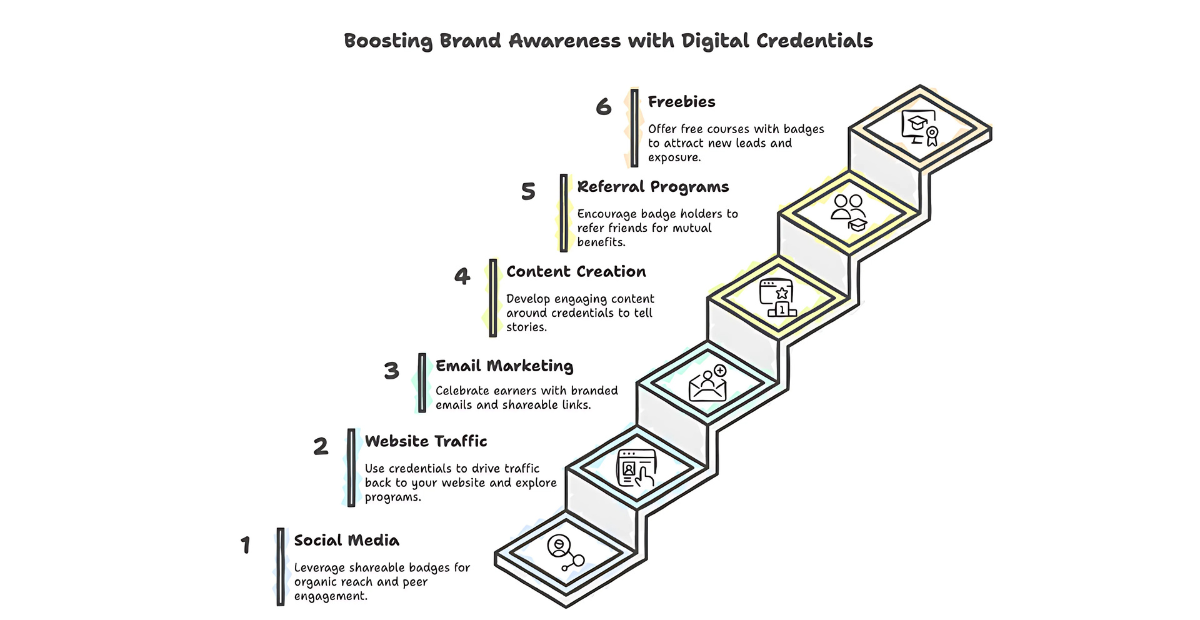
Case in Point: IBM’s Digital Badging Journey
When IBM faced talent shortages, they didn’t just post job ads.
They created a structured digital badge system to upskill employees and recognize achievements.
The result?
-
87% more engagement from learners
-
A clear roadmap of who has what skill
-
Global recognition of IBM’s commitment to growth
They turned internal learning into a branding powerhouse—and you can too.
What’s especially clever about IBM’s approach is how they treated digital badges as more than just internal tools—they made them visible, shareable, and verifiable outside the organization too. Employees proudly displayed them on LinkedIn, which, in turn, extended IBM’s brand credibility across professional networks.
Over time, those digital badges not only showcased employee development but became recruitment magnets and thought leadership symbols. When people saw an IBM badge, they didn’t just see a skill—they saw a standard.
The Secret Sauce: White-labeling + Verification = Instant Credibility
Here’s something not often talked about…
When your digital credentials are white-labeled, they carry your institution’s name, logo, and signature. Not a third-party brand.
That means:
-
Your learners remember you, not just the platform.
-
Employers associate your name with credibility.
-
You get full branding credit for every badge earned.
Plus, verifiable credentials come with metadata—like issue date, skills covered, and issuing authority. That level of transparency builds instant trust.
This is more than just design—it’s about identity. Every time a badge is clicked, your institution is reintroduced to someone new, reinforcing your values, programs, and professionalism. It’s like putting your name on every handshake, every milestone, and every achievement your learners earn. And in an ecosystem built on credibility, that kind of consistent brand reinforcement is priceless.
White-labeling also makes your digital credentials feel more intentional.
When a student sees a badge that looks like it came straight from their university—not a generic provider—it feels more personal, more official, and more memorable. It signals care and attention, two qualities that go a long way in building trust and admiration for your institution.
Digital Credentials in Education, Training, and Finance: A Smart Fit
Institutions across industries are catching on:
-
Universities use them to celebrate course completions.
-
EdTech platforms embed them in bootcamps and micro-courses.
-
Banks and finance firms issue badges for compliance and training programs.
-
Government agencies leverage them for workforce development.
Each of these sectors values two things: trust and visibility.
Digital credentials provide both by offering a secure, flexible way to highlight achievements and build professional reputation. For educational institutions, they create an ongoing connection with alumni and prospective students. For finance and government, they help verify expertise in high-stakes environments—without delay or manual checks.
What makes them especially smart in 2025 is their adaptability across learning models—whether it’s hybrid classes, fully online programs, or internal employee training. As more organizations embrace microlearning, modular education, and just-in-time training, digital credentials become a perfect fit to capture and communicate those moments of mastery.
Event and meeting professionals are also leveraging digital credentials to increase trust and engagement—here’s how.
They bridge the gap between informal and formal learning, giving learners—and institutions—a verifiable way to show what they know.
The result? A growing ecosystem where digital credentials serve both personal growth and institutional marketing. That’s not just efficient—it’s strategic.
If your goal is visibility + credibility, digital credentials check both boxes.
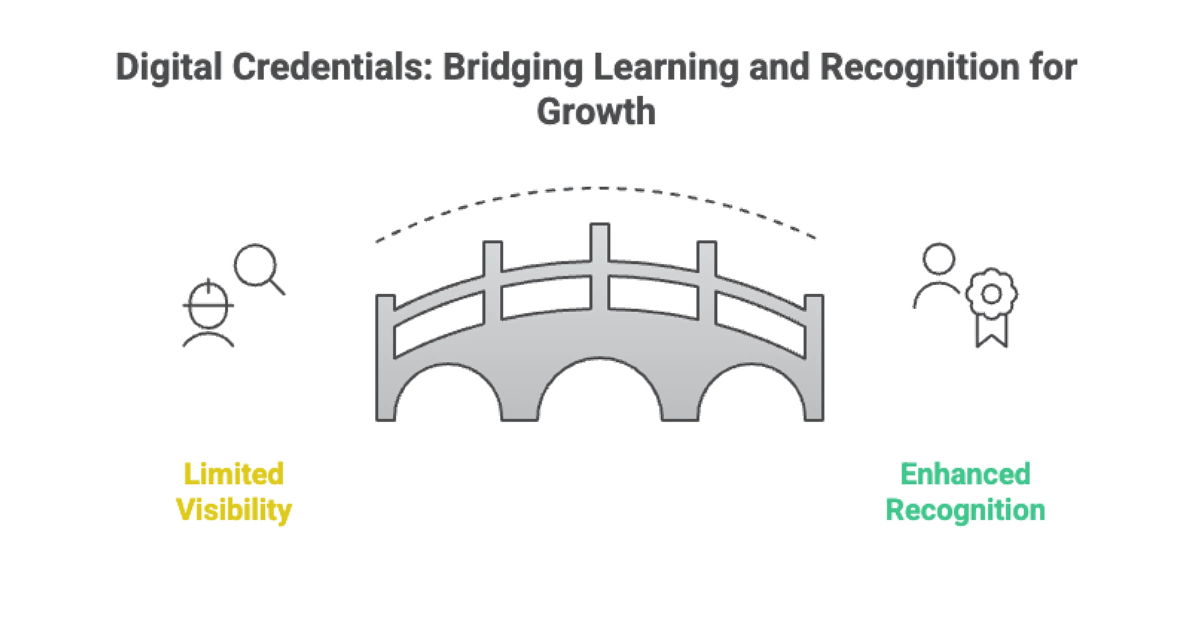
Let’s Wrap It Up: Why This Matters Now
In 2025, attention is currency.
If people don’t know your name, they can’t choose you.
And while flashy ads may catch eyes for a moment, digital credentials stick. They live in resumes, social feeds, and portfolios. They get clicked, read, verified—and remembered.
So if you’re a university registrar, department head, or marketing coordinator wondering how to get your brand seen without shouting into the void?
Start with digital credentials.
They’re not magic. They’re just smart.
Want to see how it works?
Building brand awareness in 2025 isn’t about shouting louder, it’s about being seen in the right moments. Digital credentials give universities and organizations that visibility by making every achievement shareable, trackable, and trust-worthy.
Whether it’s a student proudly posting a badge or a recruiter clicking a verified certificate, each digital credential quietly tells your story. And the more those stories get shared, the more your brand earns attention—without needing to constantly chase it.
If you’re in the registrar’s office juggling paper requests, or a student trying to make your resume stand out, digital credentials simplify both ends of the journey. They’re practical, portable, and powerful—especially when paired with thoughtful design and intentional sharing.
What starts as a certificate becomes a touchpoint: a moment where someone else sees your brand and remembers it. That’s how recognition grows—not in one big leap, but in hundreds of small, meaningful ones.
If you’re looking for a simple, secure way to issue branded, verifiable digital credentials, CertifyMe is worth checking out.
Platforms like CertifyMe make it easy:
-
Issue sleek, branded credentials in minutes
-
Track engagement and shares
-
Customize metadata and verification pages.
From white-labeled design to real-time verification, everything is built to make your job easier and your brand more visible.
Ready to see it in action? Book a demo call and explore how digital credentials can quietly speak volumes about what your institution stands for.

 Author :
Author : 


